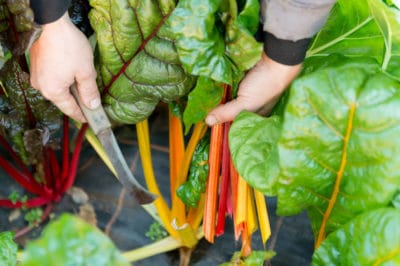Growing Swiss Chard
A bountiful harvest begins with proper growing conditions. Chard prefers a fertile, loose, well- drained soil. It also likes full sun but can tolerate some shade, especially in hot weather. Make sure chard is well-watered to prevent tough, stringy plants and a bitter taste. Chard can bestarted in the garden several weeks before the last frost and succession planted until late summer.
Swiss Chard Varieties
All varieties of Swiss chard grow well with other plants. Here are a few varieties:
- Burpee’s Rhubarb Chard – 55-65 days; purple red stalks and veins.
- Verda de Taglio – 55-60 days; Italian variety tastes like a mild spinach.
- Lucullus – 50-52 days; open-pollinated heirloom.
- Rainbow – 60 days; stalks are colored red, yellow, pink, purple and orange.
- Umaina – 55 days; tolerates both heat and cold.
Harvesting Chard for Greens
Like lettuce and some other greens, you can harvest chard one leaf stalk at a time. Cut about two inches above the ground with a sharp knife or scissors. You can begin harvesting in this fashion once the chard is about eight inches tall. One advantage of this method is that chard doesn’t hold very well in the refrigerator, so it’s better harvested fresh.
Harvesting for Seeds
If you want to grow your own, chard produces plenty of seed. A biennial, it must be wintered over and will send up a seed stalk the second spring. You should use open-pollinated varieties for consistent seeds. Only allow one variety of chard to go to seed each year to prevent cross-pollination by insects. When the seeds begin to turn brown, harvest and store in cool, dry conditions.
Harvesting the Plant
Chard freezes well, although it cooks down considerably when blanched. For freezing, it works best to harvest whole plants and process a big batch. You can cut the plant about two inches above ground level and leave the base, which may regrow. Alternately, grasp the plant close to the roots and pull out of the soil with a slight twisting motion.
Harvesting for Growth
If chard gets too big, it may get tough and develop a bitter taste. If the weather suddenly turns hot or you’ve been busy and haven’t gotten to the garden, you can harvest for a spurt of new growth. Cut the entire plant off about two or three inches above ground level. Apply a balanced 5-10-10 organic fertilizer and water well to promote growth.
